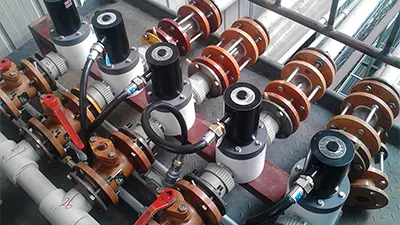 Home /
Home / Can the Valve Handle Corrosive Chemicals?
When working with industrial systems, one critical question that often arises is whether the valve can handle corrosive chemicals. Valves are essential components in controlling the flow of fluids, gases, and chemicals in a system. However, not all valves are designed to handle harsh or corrosive environments. Selecting the right valve material and design for corrosive chemicals is crucial for ensuring safety, performance, and longevity of the system.
Understanding Corrosive Chemicals and Their Effects on Valves
Corrosive chemicals, such as acids, alkalis, salts, and solvents, can damage or degrade many common valve materials over time. This degradation can result in leaks, reduced functionality, or even catastrophic failure. The corrosiveness of a chemical depends on factors such as its concentration, temperature, and pH level.
Common corrosive chemicals include:
- Acids: Sulfuric acid, hydrochloric acid, nitric acid
- Alkalis: Sodium hydroxide, potassium hydroxide
- Solvents: Acetone, methanol, ethanol
- Salts: Sodium chloride, calcium chloride
Types of Valves for Corrosive Chemicals
To ensure that valves perform effectively in corrosive environments, they must be made from materials that can withstand chemical attack. Here are some valve materials that are commonly used for handling corrosive chemicals:
- Stainless Steel (316, 304)
- 316 Stainless Steel: This is the most commonly used material for handling corrosive chemicals, especially in applications involving acids and saline solutions. It is resistant to corrosion and rust, but its performance can degrade with strong acids like hydrochloric acid.
- 304 Stainless Steel: Slightly less resistant than 316, it is still used for less aggressive chemical environments. However, it’s not ideal for highly corrosive chemicals.
- Plastic Valves (PVC, CPVC, PVDF)
- PVC (Polyvinyl Chloride): PVC valves are ideal for handling many acids, salts, and alkalis in lower temperatures. However, it is not suitable for high-temperature applications or solvents like acetone.
- CPVC (Chlorinated Polyvinyl Chloride): Offers higher resistance to temperature and chemicals than PVC, making it suitable for more aggressive chemical handling.
- PVDF (Polyvinylidene Fluoride): One of the most chemical-resistant plastics, PVDF is highly resistant to strong acids, bases, and solvents, making it a popular choice for handling corrosive chemicals.
- Hastelloy & Inconel
- Hastelloy: This alloy is designed to withstand the most aggressive chemical environments, especially in high-temperature and high-pressure systems. It is highly resistant to acids, alkalis, and chloride environments.
- Inconel: Known for its resistance to extreme temperatures and corrosion, Inconel valves are commonly used in chemical processes involving high heat and highly corrosive materials.
- Teflon (PTFE) Coated Valves
- Teflon Coatings: Valves with Teflon coatings or made from pure PTFE are highly resistant to corrosion and chemicals. They are particularly useful in handling aggressive chemicals like acids and solvents. These valves are often used in laboratory and chemical processing applications.
- Ceramic and Glass Valves
- Ceramic and glass valves can withstand extremely corrosive environments, particularly in applications where metal or plastic valves may degrade rapidly. These materials offer excellent chemical resistance, but they may not be as durable in high-pressure applications.
Key Considerations for Selecting Valves for Corrosive Chemicals
- Chemical Compatibility
- Ensure that the valve material is compatible with the specific chemicals in your system. Use a chemical resistance chart or consult with the valve manufacturer to determine the best material for your needs.
- Temperature and Pressure
- High temperatures and pressure can accelerate corrosion. Make sure the valve can handle both the chemical and the operating conditions of your system.
- Valve Design
- Consider the valve's design, including its seals and gaskets. Materials like PTFE, Viton, and EPDM are often used for sealing corrosive fluids because of their resistance to chemical attack.
- Maintenance and Lifespan
- Valves handling corrosive chemicals require more frequent maintenance. Choose a valve material that has a long lifespan and is easy to maintain to reduce operational downtime and repair costs.
- Cost Considerations
- Corrosion-resistant materials can be more expensive, but the cost of replacing failed valves or dealing with system downtime can be much higher. Make sure to balance cost against long-term reliability.
Conclusion
The ability of a valve to handle corrosive chemicals depends on the materials used in its construction. Stainless steel, plastic valves, alloys like Hastelloy, and special coatings like Teflon can offer high resistance to corrosion and ensure that your systems remain safe and efficient. By carefully selecting the right valve material based on the chemicals, pressure, and temperature in your system, you can enhance the lifespan of the valve and minimize maintenance issues.




